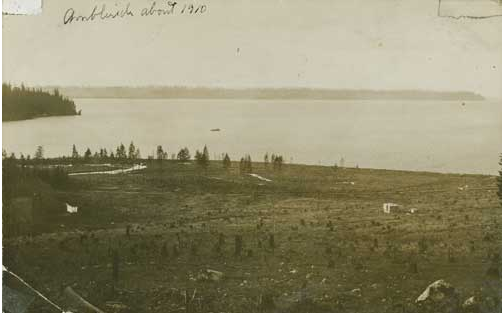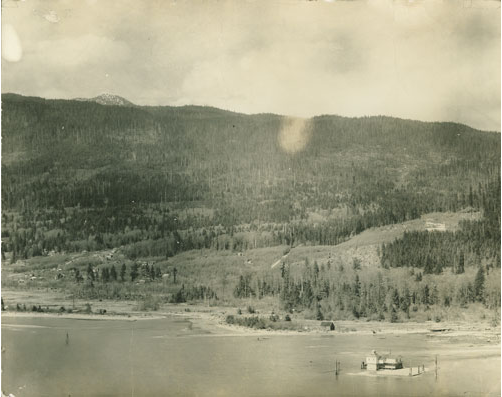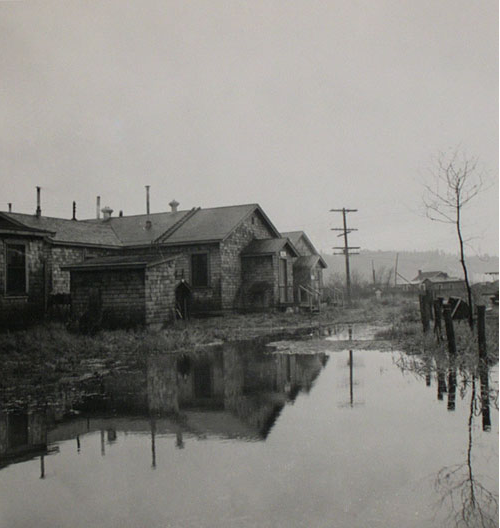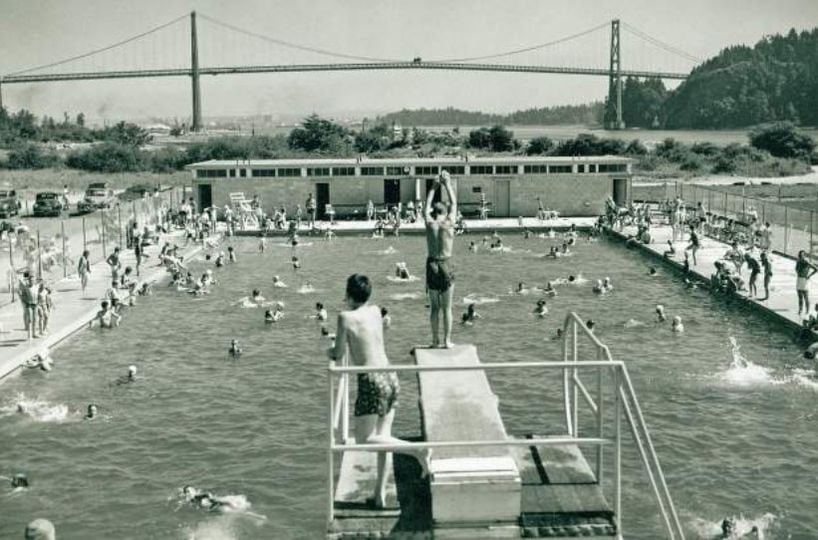If you live on the North Shore, chances are that you spend at least some of your summer at West Vancouver’s Ambleside. Did you know that you are sitting on reclaimed land? Prior to 1965, much of this land was a swamp.
In 1914, Ambleside was subdivided into 17 lots and filled with makeshift homes and a few businesses. Because much of the area was often under water, many of the structures, including Overington’s barber shop, were raised on stilts, and most comprised little more than a floor, some wooden sides and a canvas top.

A Slough:
In those days, a large slough cut through Ambleside and ran between Capilano River and 14th Street, and boats moored on the north side of Marine Drive. In the winter, residents skated on the frozen slough, in the summer they fished for cod, and shot pigeons and ducks on the surrounding marsh.

Just across from the sports field at Ambleside Park is a building that houses the Ambleside Youth Centre*. Before that it was home to the West Vancouver Rod and Gun Club, and before that it was one of 18 huts built by the Department of National Defence with four-gun emplacements and anti-aircraft guns to defend the harbour entrance below the Lions Gate Bridge during World War 11.
War Vets:
After the war, the huts were converted into housing for war vets and their families. Officially, the housing development was named the Ambleside Park Village; unofficially locals called it “Diaper Lane.” The huts were built on low land that flooded several times a year, and at those times, food and supplies were brought in by rowboat.

The playing fields and pitch-and-putt are built on sawdust, bark and wood waste from a North Vancouver sawmill. The duck lagoon was created by dredging part of the slough, while Ambleside beach is a product of 85,000 cubic metres of sand and gravel hauled from the sandbanks west of Navvy Jack Point.
Swimming Pool:
The Ambleside Swimming Pool opened on July 9, 1954. After several money losing years, the heated pool was closed in 1976 and filled in the following year.

- The building was demolished in March 2019
Related:
© All rights reserved. Unless otherwise indicated, all blog content copyright Eve Lazarus.




40 comments on “West Vancouver’s Ambleside: Then and Now”
Thanks for the history lesson. My wife and I have walked the sea wall from Ambleside to Dundarave a few times. Awesome scenery and a pleasant mostly cyclist free walk.
Is the timing of this post coincidental with a “3 day rock and roll” event planed for Ambleside?
I cant imagine why the people of West Van would be interested in this sort of event.
No, total coincidence. Was walking the dog there last week.
Some of us were born and raised in West Vancouver during the 60’s and 70’s and are wholeheartedly looking forward to Rock Ambleside
Exactly!
Really great post, Eve!
I first learned about the slough when I heard the history of the First Nations burial ground on the hill behind Park Royal Towers. The burial ground seemed to be in an unlikely spot until I read that the Ambleside slough once extended to the base of the hill.
For centuries I expect, mourners would canoe up the slough and lay the departed to rest on the hill above.
Knowing that, I now walk along Pound Road quietly.
My late mother, father, grandparents and great grandparents and so on are buried in that cemetery. Not it sits amongst a concrete jungle.
Thank you!
Both my Mom and Dad families lived on Ambleside beach when they were very young!!
Me too. 1950’s. Dunerave beach, marine drive, down from the pier, in front of big rock
Two things to note:
First the cemetery located above Park Royal is still in use. Chief Joe Mathias was buried there, an event I attended.
Second: A large part of the original Indian Reserve, mostly what is now Park Royal South, were originally included the Reserve. Theses lands were “Cut Off Lands” assumed to be surplus to any requirements the Squamish Nation would have, and were removed after the 1916 Royal Commission (McKenna/McBride) and came into the hands of the province. In later years, when Hon Allan Williams was the sitting MLA for West Vancouver, and the B.C. Minister Responsible for Indians, he was unable to persuade the Cabinet to pay the compensation for those lands to the Squamish First Nation, which would have kept those lands in the provincial system. The amount involved was approximately $8.0M, but the residents of West Vancouver were not at all pleased that those lands were returned to Squamish. I grew up in North Vancouver, swam at Ambleside, and learned to shoot at the Rod and Gun Club…and we had family friends living in houses on stilts on reserve on the other side of Lions Gate Bridge. When we visited there you checked the tides first, since the long walkways out to the house were periodically covered by the rising tide.
Fascinating, thanks so much for all this great information.
Thanks for this Ambleside info and your post. So interesting! Did you say this is included in one of your books? My Mum was raised in Vancouver and had family in West Van that she visited via the ferry at the time….would love to show her the history!
It’s not in any of my books – but probably should be! I came across the history when I was doing some research for the North Vancouver Museum and Archives. It was part of an exhibit called Water’s Edge
when it was returned to my people you say the residents of west van weren’t happy. Boo boo how do you think my ancestors felt when they were forced to leave? My great grandfather had a longhouse where winner area is.
I grew up in West Van in the 50’s and ’60s (22nd & Nelson Ave., then Thompson Place and 31st) and also learned to shoot at the R&G Club @ Ambleside. (Wish I had one of those lovely little BSA Martini .22s now.) I was corresponding with someome who also used to shoot there and I wondered when the shooting range closed down, which lead me to this blog. I can’t imagine such a thing these days! (Are we even allowed to admit to such “primitive” activity here?)
Haven’t been back there for several years since I moved out of the West End and relocated out to Mission. but I remember walking the sea wall from my mother’s apt. at Dundarave and strolling through Ambleside. I do miss Ambleside Bean Around the World, though. Time for a drive in to reconnect.
Ambleside holds many happy memories for me! My grandmother Ethel Brown lived on the ninth floor of The Windsor of Park Royal Towers. When I was growing up in the 70’s our family would visit almost every weekend in the summer and spend the whole day at Ambleside. Nana loved to bring a picnic lunch, her thermos of coffee, and a paperback to read while me and my 2 older sisters swam for hours on end. We also would volunteer to walk the dogs from the S.P.C.A. Best memories ever!
[…] Lazarus looks back on the creation of Ambleside, in West Vancouver. This lovely beach apparently used to be a […]
Thanks for this interesting info. I walk the seawall daily and love it! Always something new to see. I remember in the fifties playing off the dundarave pier.
Hi Eve, my parents lived in the Navvy Jack house at 17th and Argyle. It was built in the late 1860s and was the oldest known continuously occupied house in the lower mainland. They bought it in the late 1960’s and lived there for 51 years until my father’s recent passing this April. Dad had a wonderful flower and vegetable garden right there on the beach and talked to everyone who passed by on the seawall. We have so many fond memories of this grand old place.
Jane Williams
I love that house. What an amazing history, and so great that your family was such a large part of it! Do you know what’s happening with it now?
Looking forward to our chat, Eve. We’re hoping it will be a nature house facilitated by the Stream Keepers. JW
Back in 2018/19 it was the house of a John Lawson Park homeless man and I’m sure you know now that it they are working on a plan for restoration.
I used to swim at Ambleside pool. I think it’s a skateboard park now.
We Just Kinda Moved In And Took Over.
There’s A Large Piece Of The Story Missing.
But I Don’t Think Most People Want To Hear
The Ugly Truth.
We moved to Ambleside in August, 1946. The trenches, barbed wire and a quonset hut were still there. The duck pond was a natural part of the slough. A simple dam with a spill way allowed water to enter at high tide and and ensured that the pond maintained a depth of about 10 feet in the middle. Spring tides allowed two arms of the slough to be navigable by rafts we constructed as far as Marine Drive and almost to Begg’s Grocery Store at 13th and Bellevue.
I was a ‘Swamp Rat’ for many years and the slough was our adventure playground. My greatest find, washed up on Ambleside Beach was Half of a dugout canoe split down the middle and 18 feet long. We skimmed over the calm waters of the slough in this marvelous find.
Several decrepit homes stood on stilts were the Hollyburn Sailing Club now stands. The irony is that these waterfront dwellings were considered a local slum at that time !
Such a great memory! Thanks so much for stopping by.
I still have the old west van High school annuals, I graduated in 1960 would have to spend some time looking for them though
I have lived in both north van and west van 4084Wellington Crescent in North Van & 2955 Roseberry Ave in West van great spots both of them. I live in Australia now and Love the climate here but LOVE getting back to the north shore when possible
Which part of Australia?
I have just come across this website. I too grew up in North Vanc. & now live in Australia!!! I was googling Ambleside as I learnt to swim in the pool there with the free Vancouver Province summer lessons. Cheers.
I have wonderful photos of my family & I (age 3 ) enjoying the beach around 1946 . Long before the swimming pool, it was a favorite place to picnic & swim .
Fine post
Thank you!
I lived in a rented cottage where John Lawson Park is now located from when I was an infant until 1955. I remember seeing John Lawson himself present at the opening of the park. As young children we would sometimes go to the slough although we were told not to by our parents. We also played in the gun emplacement under the Lions Gate Bridge, a three story concrete WW 2 building. Some of the buildings from the 20s were still located at the foot of 13th, notably a second hand/junk store that sold, amongst other things, old fashioned cylindrical records. Also located in JL Park as it now is, was Vim’s boat rental and soda shop. There were floating wharfs beside the 17th Street pier and a slip way going into the water so that the wooden inboard motor boats that Vim rented for fishing could be hauled out of the water by a donkey engine. In the area between 16th and 17th were remnants of the original Lawson farm including a dilapidated shed. The PGE didn’t reoccupy the original roadbed until 1955 and although some signs of it were probably there it seemed hard to believe that trains had ever gone through West Van.
This is so interesting. Thanks for adding to the story David
I would like to add one other important piece to the history of what is commonly referred to as the Rod and Gun Club building. Before it became a youth centre it was a high school. Operated by Sentinel Secondary it was called SWAP, an acronym for Sentinel Work Activity Program. In the mid 70’s the term ‘alternate schools’ became quite popular. Recognizing that many students simply did not fit into the traditional education system various private and public Alternate Schools started popping up. Today, some 45 years later SWAP can be proud to be one of the most successful schools of it’s type as it is still going strong today and currently operates at the Lucas Centre.
Started in 1973 or 74 Ambleside Park and the Rod and Gun Club made the perfect home for such a program. As a bonus it was also located next to the SPCA which provided a positive distraction when the desire arose.
Among the many unique aspects of the program was the ‘W’ in SWAP which stood for work. An arrangement had been made with McMillan Bodell to log firewood on land above Porteau Cove. Run as a small business the school rented passenger vans or small trucks, acquired chainsaws and other equipment and involved the students in all aspects of the enterprise. A small group of students would spend one day a week travelling to Porteau. Depending on the day they would either cut down trees, cut up firewood or load a truck and sell in the community. On Friday afternoon the profit made from that weeks sales was divided by the total number of hours the students worked and each participant would get paid based on how many hours they had worked. It made for a perfect source of spending money for the weekend. In addition numerous skills were passed on from the fundamentals of a business to maintaining the chainsaws to safety.
Despite the perception and initial expectation that the program was for students who were problem kids & academically challenged many students actually graduated grade 12 with academic math and english. Even in mainstream high schools only a limited number of students achieved that. Many students went on to University and successful professional careers.
The principal and hands on leader was a remarkable teacher named Dave Scott. In addition to creating what was known as Boys SWAP he also oversaw the creation of Girls SWAP which was housed in the Mason’s building at 17th and Bellevue.
It’s hard to imagine a more amazing location than in the middle of Ambleside Park, beside the SPCA the pitch and putt and the beach. It even had a ping pong table in the main room. It was fitting that in 1975 the first formal graduation party was held at the old Road House Cabaret near the 2nd Narrows bridge. It was better known as a biker bar in it’s time.
That’s really interesting and I didn’t know any of that! Thanks so much for adding to the story.
[…] tenancy. It’s the last one following a council decision in 1975 to buy up the 32 houses along the Ambleside waterfront between 13th and 18th either through land sales or expropriation. With the exception of the Silk […]
I lived on Marine Dr, down from the pier in the 60s on the beach. Every Saturday spent .35$ at the drugstore on Marine Drive on chocolate cherrie (split with my brother)
Good life
I lived at 1451 Bellvue from 1951 to 1960. Loved that area for roaming around. My sister took lessons at the pool. My best friend lived on Argyle so we enjoyed the beach as well